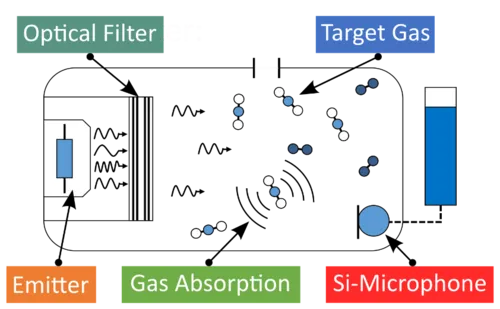Environmental sensing using miniaturized photoacoustic gas spectroscopy
Carbon dioxide (CO2) is considered one of the most important agents in the Earth's climate system. It is not only responsible for the greenhouse effect that promotes global warming but also highly toxic in higher concentrations. It is on the other hand a necessary resource for the sustaining of life by producing oxygen through photosynthesis – thus forming both foundation and threat to all life.
Due to this critical role of CO2, it is generally in the human interest to monitor the environment for its concentration, in order to draw conclusions about CO2-induced effects and mechanisms. Miniaturized photoacoustic spectroscopy (PAS) provides a way to measure CO2 in a cheap and robust way with small form factors.
PAS sensors comprise a measuring chamber, an (infrared) emitter and a microphone. The underlying principle is the so-called photoacoustic effect: light of a certain wavelength excites the gas molecules to be detected, which in turn emit this excitation as heat to surrounding molecules. This emitted heat leads to a pressure surge in a closed measuring chamber, which a microphone can measure (See Figure 1)

The research project is carried out in cooperation with Infineon Technologies AG and, based on the state of the art, aims to overcome the current limits of miniaturization. This is achieved by dividing the basic sensor concept into individual components, which are physically modeled to determine their contribution to the performance of the entire sensor.